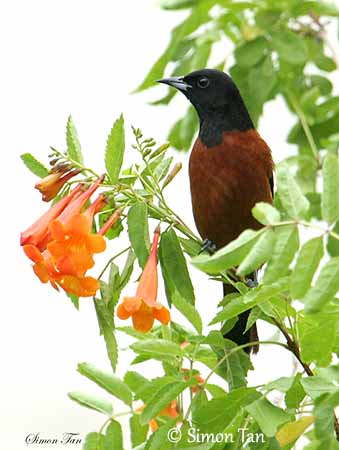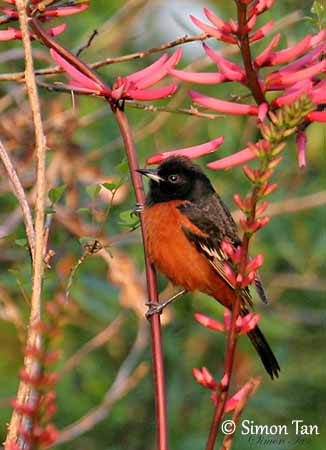
Fr: Oriole des vergers
Ang: Orchard oriole
All: Gartentrupial
Esp: Turpial Castaño
Ital: Oriolo degli orti
Nd: Tuintroepiaal
Sd: Trädgårdstrupial
Photographer:
Simon Tan
PBase Bird galleries
Text by Nicole Bouglouan
Sources:
HANDBOOK OF THE BIRDS OF THE WORLD Vol 16 by Josep del Hoyo- Andrew Elliot-David Christie – Lynx Edicions – ISBN: 9788496553781
NEW WORLD BLACKBIRDS – THE ICTERIDS by Alvaro Jaramillo and Peter Burke – Helm - ISBN : 0713643331
A GUIDE TO THE BIRDS OF MEXICO AND NORTHERN CENTRAL AMERICA by Steve N. G. Howell, Sophie Webb - Oxford University Press - ISBN: 0198540124
A GUIDE TO THE BIRDS OF COLOMBIA by Steven L. Hilty and William L. Brown - Princeton University Press – ISBN 069108372X
FIELD GUIDE TO THE BIRDS OF NORTH AMERICA by National Geographic Society - National Geographic Society - ISBN: 0792274512
BirdLife International (BirdLife International)
All About Birds (Cornell Lab of Ornithology)
Animal Diversity Web (University of Michigan Museum of Zoology)
What Bird-The ultimate Bird Guide (Mitchell Waite)
Wikipedia, the free encyclopaedia
Orchard Oriole
Icterus spurius
Passeriformes Order – Icteridae Family
INTRODUCTION:
The Orchard Oriole is currently treated as monotypic species. However, the race I. fuertesi is sometimes regarded as subspecies of I. spurius, but it is more often considered a full species and called the Ochre Oriole. It occurs on the Caribbean coast of Mexico.
The Orchard Oriole is a long-distance migrant and they often gather in flocks during migration. It is the smallest north-American oriole. This species is often described as “semi-colonial” with several nests in the same tree when they are abundant in the same area. But usually, this species is solitary nester in most parts of its breeding range.
The population of the central plateau of Mexico is sometimes considered a subspecies, the race “phillipsi”. This bird is larger than I. spurius, the juveniles have paler underparts and greyer upperparts, but the females of both races are similar. But these differences are barely detectable.

DESCRIPTION OF THE BIRD:
Biometrics:
Length: 15-17 cm
Wingspan: 23-26 cm
Weight: 20-21 g
The Orchard Oriole adult male has black head, neck, nape, upper breast, back and scapulars. Rest of plumage, rump, lower breast, belly, vent and undertail-coverts are rich chestnut, with yellowish tips to feathers especially on the underparts.
The wings are black with narrow white wingbar and white-edged flight feathers. We can see chestnut epaulets formed by lesser and median coverts. The tail is black.
The black bill is thin and pointed, with bluish-grey base of lower mandible. The eyes are dark brown. Legs and feet are bluish-grey.
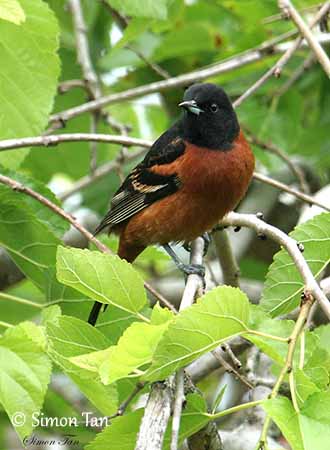
The female has olive-green upperparts, with brownish wings and two narrow white wingbars. The underparts are bright greenish yellow, with ochraceous wash on breast.
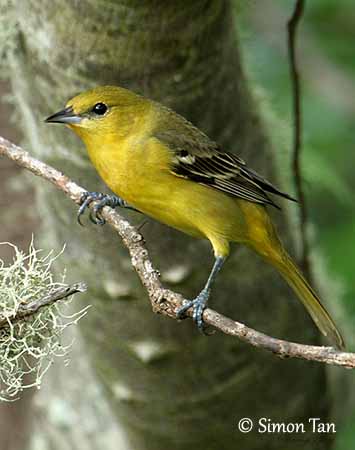
The juvenile is duller than female with buffy-white wingbars. The bill is pinkish first, and becomes darker gradually.
The 1st year male resembles female, but it shows black bib and face, and we can see some chestnut feathers on body.
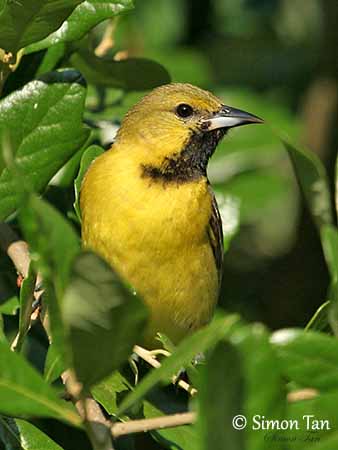
RANGE:
The Orchard Oriole breeds in S Canada, most parts of E United States, and S in Mexico, rather in the eastern part of North American continent.
It winters in both Mexico coasts, Central America and northern South America, as far as northern Columbia and NW Venezuela.
The Orchard Oriole migrates over southern Florida in large numbers.
HABITAT:
The Orchard Oriole breeds in gardens, orchards, suburban areas, along streams and lakes, and in riparian areas, floodplains or marshes.
It winters in plantations, second grows, savannas, light woods, parks and gardens. It usually avoids the dense forests.
During migrations, it frequents the forest edges with flowering trees and fruits.
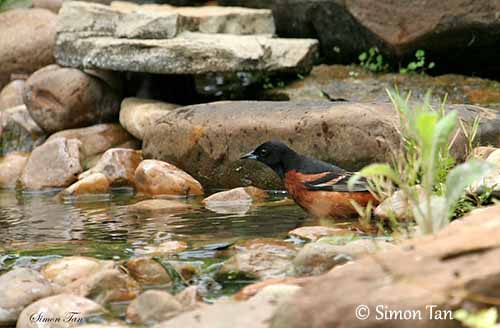
CALLS AND SONGS: SOUNDS BY XENO-CANTO
The Orchard Oriole’s calls include a sharp “chuck” as contact call and a rapid chatter as alarm call. The song is a loud, rapid series of musical whistled notes, interspersed with harsh notes, and often ending in downwards slur.
The female may sing occasionally.
BEHAVIOUR IN THE WILD:
The Orchard Oriole gleans insects from twigs and leaves but it also consumes ripe fruits, berries, nectar from flowers, and small seeds during the breeding season. It forages in open areas where it catches grasshoppers. It rarely feeds on the ground. During migration, it feeds frequently on fruits, berries and nectar from flowers. During winter, it forages in low bushes and consumes nectar of tropical flowering trees, and insects.
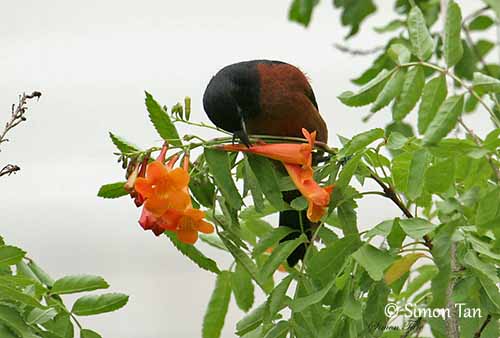
The adult male sings when it reaches the breeding grounds, in order to attract a female, and probably to establish both foraging and nesting sites. During the nesting season, the male defends its areas from second year males. It defends the nest site in the areas where several pairs are nesting together.
Courtship displays are performed by both sexes. These displays include “bowing” with head lowered, “seesawing” with head and tail bobbed alternately, “begging” with wings fluttering and accompanied by high trill. The male also uses aerial displays, bobbing head and tail while performing a butterfly-like flight. They are monogamous.
Outside breeding season, the Orchard Oriole is relatively gregarious.
They often breed in loose colonies, also with other species. During winter, they roost in large numbers in mixed groups.
The Orchard Oriole is a diurnal bird, except during migrations. They leave their breeding range once the young have fledged, and arrive in August at their wintering grounds.
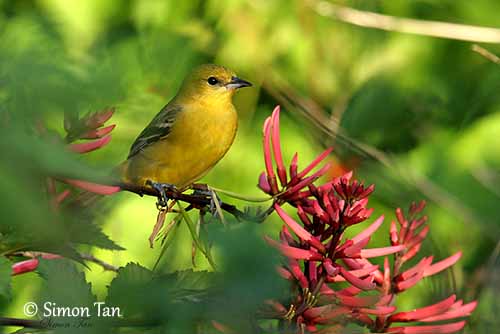
The Orchard Oriole performs a light and buoyant flight with rapid wing beats. The male performs typical flight, using fluttering and hovering at about 50 cm of high, just before perching near mate or nest.
It also performs swift and direct flight with steady, deep wing beats. It usually flies at treetop level or below.
REPRODUCTION OF THIS SECIES:
The breeding season varies with the range, and usually occurs in April-June in S USA, later in north.
The nest of the Orchard Oriole is a hanging cup built by the female. It is situated in the fork of small branches in trees with relatively loose foliage, such as willows or magnolias. The female often builds the nest in Spanish moss. She needs about one small week to make it. The nest is made with woven long vegetal fibres, and lined with hair, yarn, fine grass, feathers and other soft materials.
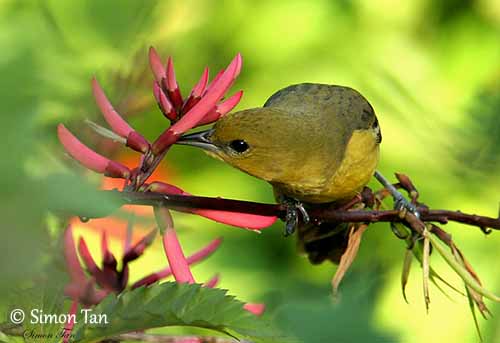
The female lays 3-7 light blue eggs with dark markings. The incubation lasts about 12 to 14 days, by female. She is fed by the male which also guards the nest. The chicks are covered with grey or buff down. They are fed by both adults.
They leave the nest about 11 to 14 days after hatching. They stay close to the nest in densely covered habitat during one week. Then, both female and young remain in the area. They feed on fruits until they start to migrate in August.
This species produces one brood per season, but a second brood may be laid if the first is lost early in the season.
PROTECTION / THREATS / STATUS:
The Orchard Oriole’s eggs and chicks are preyed upon by Common Grackles. The nests are parasitized by cowbirds. The adults can be preyed upon by larger birds.
The Orchard Oriole may help in insect population control. It spreads the seeds contained in eaten fruits in other areas. When it feeds on nectar, it sometimes pierces the flower at its base, but in other flowers, the bird serves as a pollinator.
The population of Orchard Orioles appears stable in spite of habitat loss by degradation and use of pesticides in orchards. The species has wide range and is currently evaluated as Least Concern.
